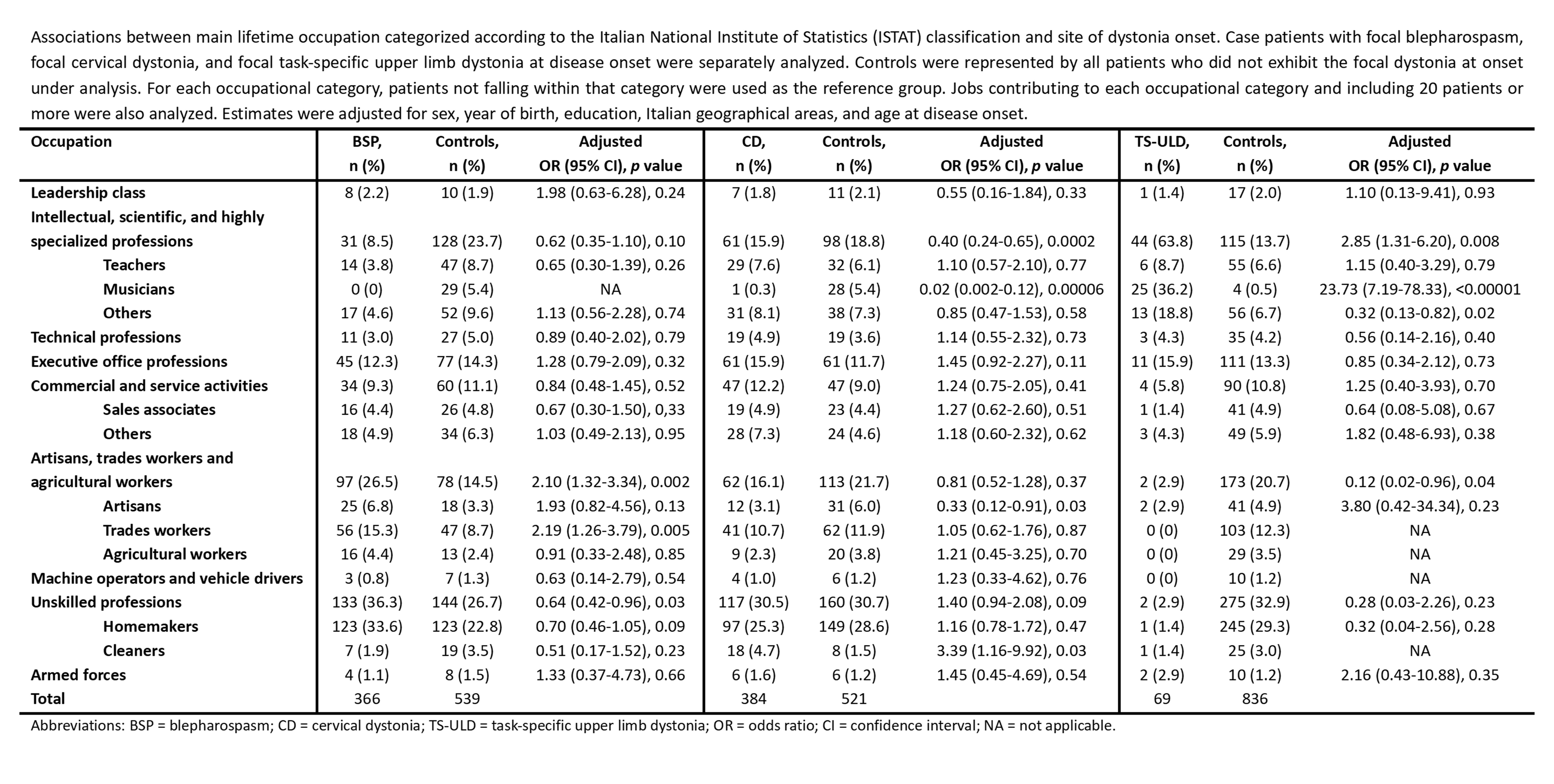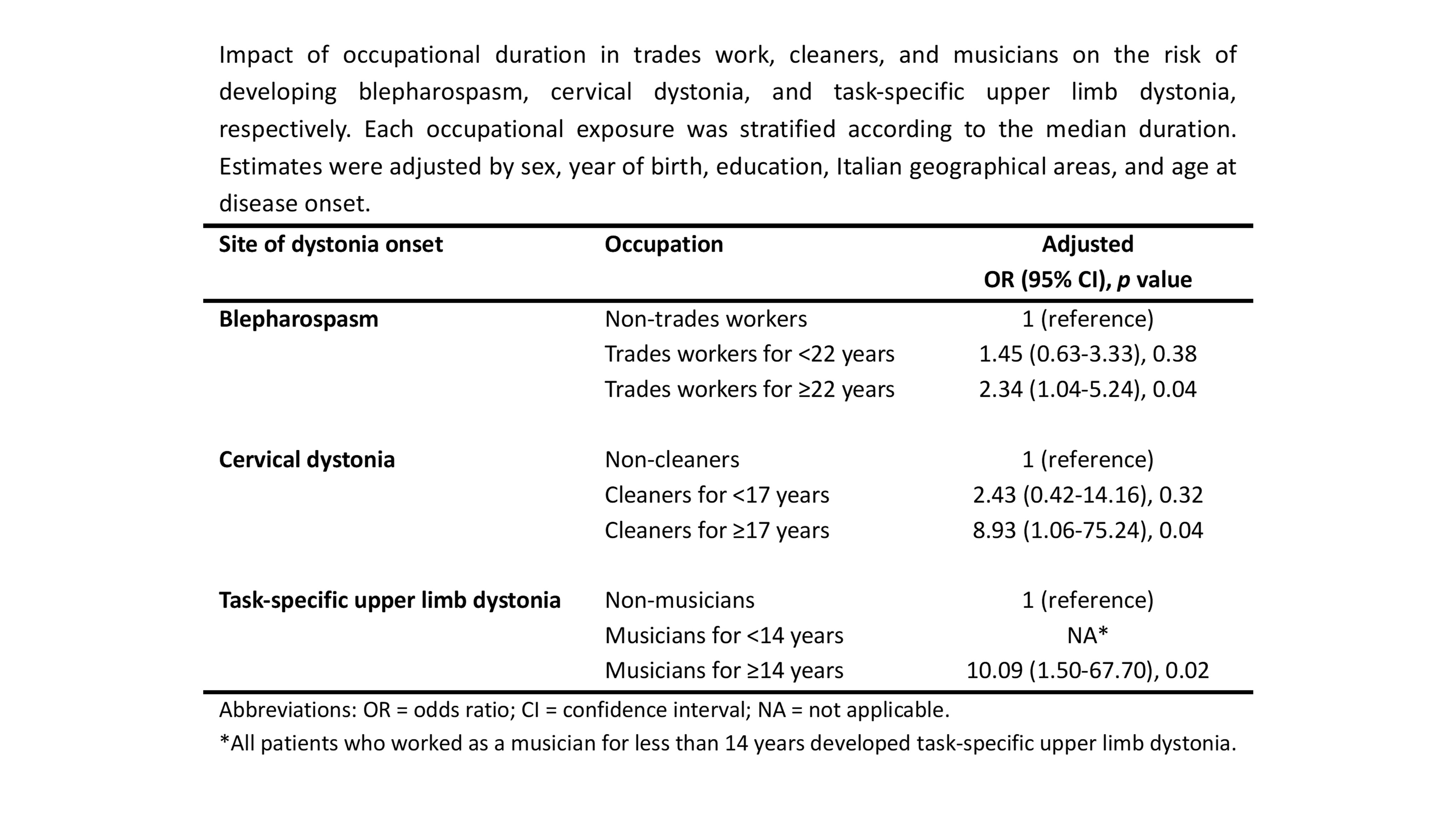Objective: This study aimed to investigate whether certain occupations are associated with an increased risk of developing specific focal forms of idiopathic adult-onset dystonia (IAOD), namely blepharospasm (BSP), cervical dystonia (CD), and task-specific upper limb dystonia (TS-ULD).
Background: IAOD manifests in various focal forms, potentially arising from the interaction between genetic predisposition and environmental factors [1,2]. Some occupations have been identified as risk factors for TS-ULD, leading to the concept of “occupational dystonia” for conditions like writer’s cramp or musician’s dystonia, triggered by repetitive, intensive training [3-5]. However, the potential role of occupation in developing other forms of IAOD has not been systematically explored.
Method: Data from 905 IAOD patients with focal onset enrolled in the Italian Dystonia Registry [6] were analyzed. Each patient was assigned to the corresponding occupational category by specialists in occupational medicine according to the classification by the Italian National Institute of Statistics. Logistic regression models (adjusted for sex, year of birth, education, Italian geographical areas, and age at dystonia onset) were computed to assess the association between occupation and specific dystonia at onset, using patients who developed focal dystonia in other body parts as controls.
Results: Compared to other professions, trades workers exhibited an increased risk for BSP (OR = 2.19, 95% CI 1.26-3.79), cleaners for CD (OR = 3.39, 95% CI 1.16-9.92), and musicians for TS-ULD (OR = 23.73, 95% CI 7.19-78.33) [table1]. The longer the duration of employment before the onset of dystonia, the greater the risk of developing that specific focal dystonia [table2].
Conclusion: Our findings provide novel insights indicating that exposure to specific occupations may trigger specific focal forms of IAOD, namely BSP, CD, and TS-ULD. The identified associations may have biological plausibility and likely reflect common pathophysiological mechanisms, based on the frequent performance of repetitive movements in a specific body part. Under this scenario, the term “occupational dystonia” should be extended beyond the traditionally recognized forms of TS-ULDs.
Table 1
Table 2
References: [1] Sciamanna G, El Atiallah I, Montanari M, Pisani A. Plasticity, genetics and epigenetics in dystonia: An update. Handb Clin Neurol. 2022;184:199-206. doi: 10.1016/B978-0-12-819410-2.00011-4. PMID: 35034734.
[2] Velucci V, Idrissi S, Pellicciari R, Esposito M, Trinchillo A, Belvisi D, Fabbrini G, Ferrazzano G, Terranova C, Girlanda P, Majorana G, Rizzo V, Bono F, Idone G, Laterza V, Avanzino L, Di Biasio F, Marchese R, Castagna A, Ramella M, Lettieri C, Rinaldo S, Altavista MC, Polidori L, Bertolasi L, Tozzi MC, Erro R, Barone P, Barbero P, Ceravolo R, Mascia MM, Ercoli T, Muroni A, Artusi CA, Zibetti M, Scaglione CLM, Bentivoglio AR, Cotelli MS, Magistrelli L, Cossu G, Albanese A, Squintani GM, Schirinzi T, Gigante AF, Maderna L, Eleopra R, Pisani A, Cassano D, Romano M, Rizzo M, Berardelli A, Defazio G; Italian Dystonia Registry Participants. Does sex influence the natural history of idiopathic adult-onset dystonia? J Neurol Neurosurg Psychiatry. 2024 Mar 1:jnnp-2023-332927. doi: 10.1136/jnnp-2023-332927. Epub ahead of print. PMID: 38429083.
[3] Roze E, Soumaré A, Pironneau I, Sangla S, de Cock VC, Teixeira A, Astorquiza A, Bonnet C, Bleton JP, Vidailhet M, Elbaz A. Case-control study of writer’s cramp. Brain. 2009 Mar;132(Pt 3):756-64. doi: 10.1093/brain/awn363. Epub 2009 Jan 29. PMID: 19179376.
[4] Stahl CM, Frucht SJ. Focal task specific dystonia: a review and update. J Neurol. 2017 Jul;264(7):1536-1541. doi: 10.1007/s00415-016-8373-z. Epub 2016 Dec 30. PMID: 28039522; PMCID: PMC5502053.
[5] Passarotto E, Doll-Lee J, Altenmüller E, Lee A. Practice behaviors as trigger factor for the onset of Musicians’ Dystonia. J Neural Transm (Vienna). 2023 Dec;130(12):1561-1569. doi: 10.1007/s00702-023-02689-4. Epub 2023 Aug 26. PMID: 37633870; PMCID: PMC10682052.
[6] Defazio G, Esposito M, Abbruzzese G, Scaglione CL, Fabbrini G, Ferrazzano G, Peluso S, Pellicciari R, Gigante AF, Cossu G, Arca R, Avanzino L, Bono F, Mazza MR, Bertolasi L, Bacchin R, Eleopra R, Lettieri C, Morgante F, Altavista MC, Polidori L, Liguori R, Misceo S, Squintani G, Tinazzi M, Ceravolo R, Unti E, Magistrelli L, Coletti Moja M, Modugno N, Petracca M, Tambasco N, Cotelli MS, Aguggia M, Pisani A, Romano M, Zibetti M, Bentivoglio AR, Albanese A, Girlanda P, Berardelli A. The Italian Dystonia Registry: rationale, design and preliminary findings. Neurol Sci. 2017 May;38(5):819-825. doi: 10.1007/s10072-017-2839-3. Epub 2017 Feb 18. Erratum in: Neurol Sci. 2018 Apr 18;: PMID: 28215037.
To cite this abstract in AMA style:
V. Velucci, L. Di Lorenzo, R. Erro, I. Di Somma, M. Esposito, A. Trinchillo, D. Belvisi, G. Fabbrini, G. Ferrazzano, S. Idrissi, R. Pellicciari, L. Avanzino, F. Di Biasio, C. Terranova, V. Rizzo, A. Castagna, M. Ramella, F. Bono, M. Barillari, M. Altavista, L. Polidori, C. Lettieri, C. Artusi, C. Scaglione, P. Barbero, L. Magistrelli, M. Petracca, R. Ceravolo, G. Cossu, T. Schirinzi, G. Squintani, A. Gigante, A. Muroni, T. Ercoli, M. Mascia, A. Berardelli, G. Defazio. Expanding the concept of “occupational dystonia”: data from the Italian Dystonia Registry [abstract]. Mov Disord. 2024; 39 (suppl 1). https://www.mdsabstracts.org/abstract/expanding-the-concept-of-occupational-dystonia-data-from-the-italian-dystonia-registry/. Accessed December 26, 2025.« Back to 2024 International Congress
MDS Abstracts - https://www.mdsabstracts.org/abstract/expanding-the-concept-of-occupational-dystonia-data-from-the-italian-dystonia-registry/


